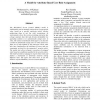27 search results - page 3 / 6 » Using uml to visualize role-based access control constraints |
ACSAC
2001
IEEE
14 years 6 days ago
2001
IEEE
The RBAC96 access control model has been the basis for extensive work on role-based constraint specification and role-based delegation. However, these practical extensions can als...
SACMAT
2009
ACM
14 years 3 months ago
2009
ACM
Traditional access control models, such as Role-Based Access Control (RBAC), do not take into account contextual information, such as location and time, for making access decision...
ICSE
2007
IEEE-ACM
14 years 8 months ago
2007
IEEE-ACM
We propose a mechanism for object access control which is based on the UML. Specifically, we propose use of ownership and immutability constraints on UML associations and verifica...
SACMAT
2006
ACM
14 years 2 months ago
2006
ACM
Separation of Duty (SoD) is widely recognized to be a fundamental principle in computer security. A Static SoD (SSoD) policy states that in order to have all permissions necessary...
ACSAC
2002
IEEE
14 years 1 months ago
2002
IEEE
The Role-Based Access Control (RBAC) model is traditionally used to manually assign users to appropriate roles, based on a specific enterprise policy, thereby authorizing them to ...

